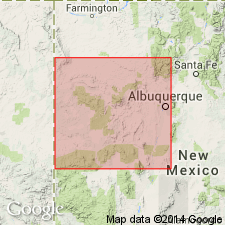
- Usage in publication:
-
- Oak Canyon Member*
- Modifications:
-
- Named
- Dominant lithology:
-
- Sandstone
- Shale
- AAPG geologic province:
-
- San Juan basin
Summary:
Named as basal member of Dakota Sandstone for exposures on sides of small mesas west of Oak Canyon, 4-5 mi northeast of Laguna, Valencia Co, NM in San Juan basin. Type section measured at NE1/4 SE1/4 sec 20 and SW1/4 NW1/4 sec 21, T10N, R5W, Laguna quad. Lower part composed of coarse to very fine-grained, locally conglomeratic (granule and pebble size clasts) and silty, sandstone. Carbonaceous, almost coaly shales and medium- to dark-gray shale present at many localities. Bentonite beds present but not common. No megafossils; trace fossils in sandstone beds; and Early Cretaceous, Albian-Aptian palynomorphs. Is 33 ft thick at type. Lower part deposited in a lagoonal, littoral, or shallow marine environment, marginal to shoreline; upper part mostly of open-marine environment. Upper part composed of dark-gray clay shale and silty clay shale, gray clayey siltstone and siltstone, thin bentonite beds, and two gray, silty limestone beds. Contains fossils of Thatcher age indicative of shallow-water. Is 40 ft thick at type. Overlies Morrison Formation unconformably; underlies Cubero Sandstone Tongue of Dakota.
Source: GNU records (USGS DDS-6; Denver GNULEX).
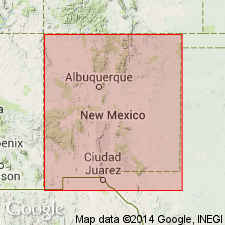
- Usage in publication:
-
- Oak Canyon Member*
- Modifications:
-
- Age modified
- AAPG geologic province:
-
- San Juan basin
Summary:
Is a member of Dakota Sandstone in the San Juan basin. Age changed from Early and Late Cretaceous to Late Cretaceous, or Cenomanian, on basis of presence of PYCNODONTE cf. P. KELLUMI.
Source: GNU records (USGS DDS-6; Denver GNULEX).
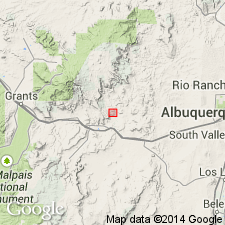
- Usage in publication:
-
- Oak Canyon Member
- Modifications:
-
- Revised
- AAPG geologic province:
-
- San Juan basin
Summary:
Unconformably overlies the Jackpile Sandstone Member which in this report is removed from the Brushy Basin Member as its uppermost informal economic unit and assigned as a formal upper member of the Morrison Formation. Lower contact of Oak Canyon is thus revised in the San Juan basin wherever the Jackpile occurs.
Source: GNU records (USGS DDS-6; Denver GNULEX).
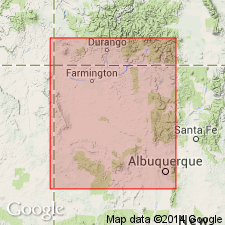
- Usage in publication:
-
- Oak Canyon Member*
- Modifications:
-
- Revised
- AAPG geologic province:
-
- San Juan basin
Summary:
Formerly thought to be the basal unit of Dakota Sandstone. Recognized in this paper as overlying the newly named Encinal Canyon Member of Dakota in the southern and eastern San Juan basin. The Encinal Canyon-Oak Canyon contact is sharp and planar. The contact is placed at the base of the grayish-orange, silica-cemented, ledgy sandstone and black shale. The base of Oak Canyon is a discontinuity resulting from minor reworking of Dakota as sea transgressed across the area. Of Late Cretaceous age.
Source: GNU records (USGS DDS-6; Denver GNULEX).
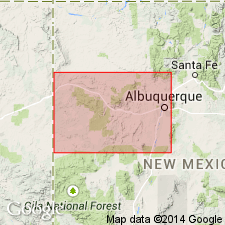
- Usage in publication:
-
- Oak Canyon Member*
- Modifications:
-
- Biostratigraphic dating
- Overview
- AAPG geologic province:
-
- San Juan basin
Summary:
Is member of the Dakota Sandstone in San Juan basin in west-central NM. Was deposited in an embayment of the Western Interior sea (the Seboyeta bay) that extended westward through west-central NM almost to Gallup, NM. Underlying unit not treated. Overlain by Cubero Tongue of Dakota Sandstone. Molluscan fossils are abundant; at least 37 bivalve species, 11 gastropod species, and 5 ammonite species are known from the area. Fauna of this member places it in the ammonite zone of CONLINOCERAS TARRANTENSE, of early middle Cenomanian age (Late Cretaceous). Figure 2 is stratigraphic nomenclature and correlation chart of middle Cenomanian to lower Coniacian rocks in west-central NM, spanning 20 ammonite zones.
Source: GNU records (USGS DDS-6; Denver GNULEX).
For more information, please contact Nancy Stamm, Geologic Names Committee Secretary.
Asterisk (*) indicates published by U.S. Geological Survey authors.
"No current usage" (†) implies that a name has been abandoned or has fallen into disuse. Former usage and, if known, replacement name given in parentheses ( ).
Slash (/) indicates name conflicts with nomenclatural guidelines (CSN, 1933; ACSN, 1961, 1970; NACSN, 1983, 2005, 2021). May be explained within brackets ([ ]).

